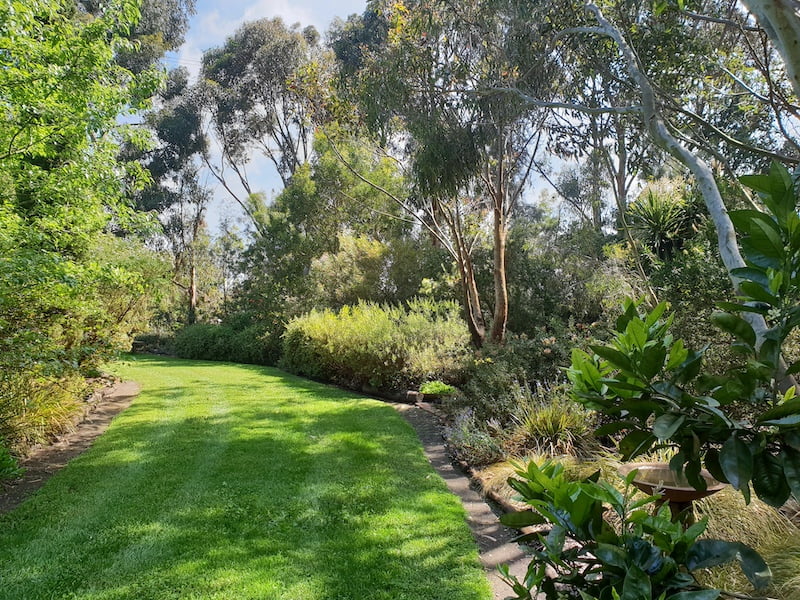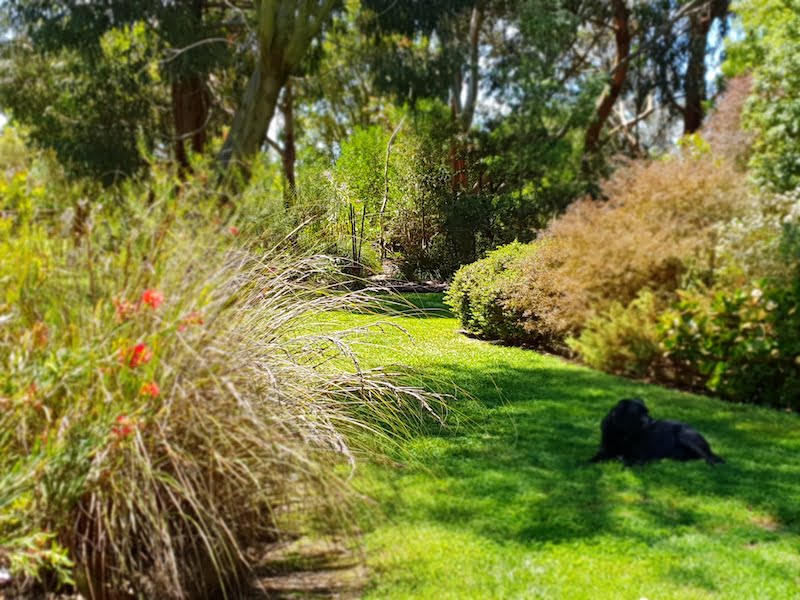While most people think that permaculture and sustainable garden styles are the same. In fact permaculture can often be exactly the opposite.
At its core, sustainable gardening has:
1) A reduction in energy use from the start of the development through all its ongoing maintenance.2) The need to preserve biodiversity and3) To minimise impact to a site.
Many botanic gardens in their original concept, were based on sustainable practice. They didn’t have the earthworks machinery to make significant change to the site; large areas of concrete paving weren’t considered, instead plants were used en masse over vast areas. These are the garden styles that I consider to be traditionally sustainable.
But garden styles have changed a lot over the last 25 years. When I first started my campaign to discourage the movement by landscapers towards less plants with more focus on outdoor entertaining, I was seen as a person who was holding back change, regarded then as inevitable.
The arguments for and against
From my own earlier experience with permaculture, and with ongoing observation, large areas of a site need to be cleared for vegetable and fruit tree growing.
This can often necessitate the removal of local, indigenous plants, especially gum trees growing too close to the designated vegetable garden area, because of perceived shade and tree roots.
And these tree roots, even from neighbouring properties, cause much angst with vegetable growers. The constant need to feed and water seasonal plants in dry periods are often caused by feeder roots from trees moving great distances.
Sustainable landscapes retain appropriate trees as much as possible and work the garden around them.
The habitats that are created among trees is enormous. They need to be preserved in this wavering, unstable environment that landscape designers and gardeners are now experiencing. If the trees are untidy, they are easily improved with removal of dead and unsightly branches.
Permaculture vegetable beds are either planted directly into the ground or created using the raised bed system. The direct method into the existing soil is the most sustainable because soil doesn’t need to be brought in to fill the raised boxes.
Unless copious mulch and manure is added to this soil in these raised beds, they can often fail. Purchased soil is often fairly inert, although there does appear to be improvement happening in this area.

Trees provide shade in hot seasons in a sustainable garden
If the existing soil of the site (and the purchased soil), for the vegetable beds doesn’t have a clay component, these beds are once again doomed to failure.
Constant adding of mulch and manure doesn’t work long-term unless there is a degree of clay present. I have tried it in my sandy soil and too much water was still required. Although repeated mulching and manuring to clay-based soils, yields excellent loam ideal for vegetable growing.
Bentonite clay is excellent for improving the water holding capacity of impervious soils. It seems to be readily available in the west, but very difficult to source elsewhere.
The fruit tree dilemma
Fruit trees consistent with permaculture need to suit the soil and prevailing weather conditions to be sustainable, without making changes to the site to accommodate them.
The flowers are an excellent food source for bees and other insects. But many fruit trees flower too early, and in cold areas, may not get pollinated because the bees aren’t active. In my experience, apricots do not do well in really cold winter areas. Other stone fruits and apple and pears also need pollinators, unless neighbours are growing these.
If fruit trees are heavy croppers, they need water if seasons are dry, to stop the fruit dropping early. Citrus also need special conditions to improve their yield. In comparison, sustainable gardens, will manage with far less water.
All gardens, even natural gardens, benefit from the application of fertilisers. In fact, well-nourished gardens require less water.
Sustainable gardens work with existing conditions with limited disruption to the site. Plants are used that will provide habitat, nectar and seeds to a vast array of birds and marsupials.
Insects including bees benefit in sustainable gardens. They are also invaluable to permaculture systems. Without bees, cross pollination wouldn’t work. In fact, it’s pointless having fruit tree crosses if there are no bees present.
Both the permaculture and the sustainable garden don’t coexist very well unless it is a big garden area. Vegetables and fruit trees need sun to perform well. They don’t like root competition from surrounding trees like gums and eucalypts, which often deplete soils of the nutrients required for permaculture growing.
Permaculture requires a lot of hard work, to keep it producing long-term. Consideration needs to be given annually to crop rotation to prevent disease and soil pH changes becoming a problem. Fruit trees need pruning. There’s also the question of how to stop birds pinching fruit? This needs to be mastered whereas with a sustainable garden, birds are welcome! And then there’s the constant application of manure and mulch to improve the soil, that the annual vegetable crops denude.

Consider the benefits of birds and local fauna in a sustainable garden
The holistic approach
As an avowed environmentalist I will always recommend a holistic, sustainable approach to garden design versus permaculture. But because of climate change even our assumed knowledge, about plants appropriate to an area or soil, is changing.
Native plants are brilliant at adaption, especially if hardy varieties that cover a broad range of soils and conditions are used. Vegetables and fruit trees, especially with difficult porous soils as the base, do not adapt and need constant attention in their growth and fruiting phase.

A relaxed sustainable garden; lawn is cooling and provides evapotranspiration
Councils once upon a time, would plant indigenous trees as verge plantings. In my council area, they remove them or plant the wrong plant, which then dies! So, it has become important for homeowners and landholders to plant indigenous trees to keep the diversity of birds and marsupials strong.
In conclusion
As a personal preference, I would always choose the serenity of a well-designed natural garden that is sustainable, over a permaculture garden.
Never forget the importance of a sustainable garden in the capacity to shield homes from extreme summer temperatures by using the right plants in the right places. Permaculture gardens don’t always manage this because most of the fruit trees are kept lower for ease of fruit picking. And often homes are double-storied. These homes require taller trees for environmental shading of the façade.
The advantage of growing site-specific gums to help soak up excess moisture in poorly drained soils, cannot be underestimated.
There are now many small mallee gums suitable for smaller gardens that are suitable for a range of drier climates including both alpine and coastal. These plants manage without supplementary irrigation, unlike heavily laden fruit trees.
There are advantages with both gardening styles. Much comes down to preference. But based on environmental impacts, I will always recommend a sustainable landscape to a client.
Reminding clients of the repeated work required to maintain a permaculture garden can often change their initial brief. I believe that ‘sustainable’ is the way of the future to help combat climate change.
As I wrote this article I listen to the vast array of different birds in my garden. It’s humid here today, so there are insects galore for insect-eating birds. Our birdbaths are full, and the natural bounty of nectar and seeds keeps our feathered friends happy. A bull koala recently roared in a gum. This is a vastly different gardening experience to the labours of growing fruit and vegetables.
